Best Historic Sites in Malta: A Guide to the Island's Rich Heritage
Last Updated: Jan 15, 2024
Reading Time: 19 minutes
By: Shaun
Malta might be a small country, but it has a long history and culture. The islands have been inhabited since prehistoric times and have witnessed the rise and fall of all the major civilizations that ruled over the area, such as the Phoenicians, the Romans, the Arabs, the Normans, the Knights of St. John, the French, and more recently, the British. Malta has also played a strategic role in several wars, such as the Great Siege of 1565, the Napoleonic Wars, and World War II.
Malta’s history and culture are reflected in its impressive and diverse historic sites, which range from ancient temples to mediaeval cities, from baroque churches to military fortifications. Malta is absolutely a paradise for history lovers, as it offers a unique and fascinating glimpse into the past.
In this post, we will guide you through some of the best historic sites in Malta and help you discover the island’s rich heritage. Whether you are interested in archaeology, architecture, art, or religion, you will find something to suit your taste and curiosity in Malta.
Let’s begin our journey through time and space and explore the best historic sites in Malta.
The Megalithic Temples of Malta
One of the most remarkable historic sites in Malta are the megalithic temples, which are among the oldest free-standing structures in the world, dating back to the Neolithic period, between 3600 and 2500 BC. These temples are built with huge stones, some weighing over 20 tonnes, and are decorated with carvings, statues, and altars.
The temples are aligned with the sun and the stars, and are believed to have been used for religious and ceremonial purposes. There are seven megalithic temples in Malta and Gozo, and they are all UNESCO World Heritage Sites. Here are some of the most impressive ones:
Ħaġar Qim and Mnajdra
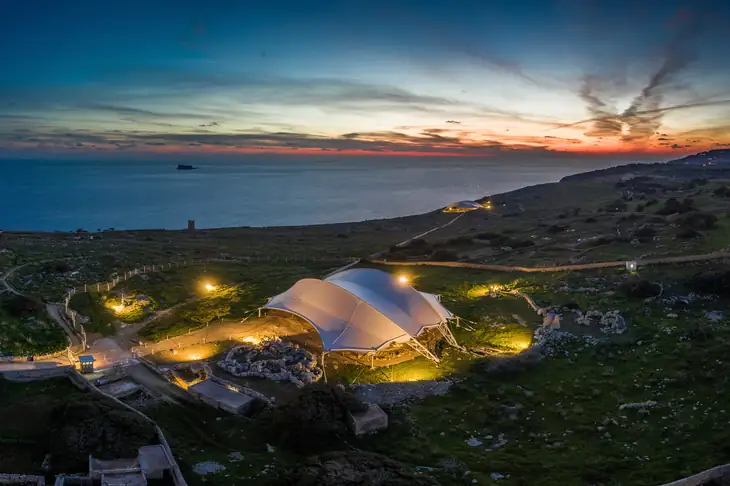
Ħaġar Qim and Mnajdra | Image by FritzPhotography on Wikimedia Commons
Ħaġar Qim and Mnajdra are two temples that are located just 500 metres apart, on a hilltop overlooking the sea and the small inhabited island of Filfla. Ħaġar Qim, which means “standing stones” in old Maltese, is the older of the two and was built around 3600 BC. It consists of a central chamber and four apses and has a large stone slab at the entrance, weighing 57 tons. The temple has several carvings of animals, such as goats, pigs, and bulls, as well as a famous statue of a fat lady, which is a symbol of fertility.
Mnajdra, which means “shrines” in old Maltese, is the more complex and sophisticated of the two and was built around 3000 BC. It consists of three temples, each with a different orientation and function. The oldest temple is aligned with the winter solstice, the middle temple is aligned with the equinoxes, and the newest temple is aligned with the summer solstice. The temples have several features, such as altars, niches, and portholes, that suggest that they were used for astronomical observations and rituals.
Tarxien Temples

Tarxien Temples | Image by Kritzolina on Wikimedia Commons
The Tarxien Temples are a complex of four temples that are located in the town of Tarxien. They were built between 3600 and 2500 BC and are the largest and most elaborate of the megalithic temples in Malta. The temples are connected by a series of passageways and have several chambers and apses, each with a different function and decoration.
The structures date back to the 4th century BCE, are thought to have been in use for over 1,000 years, and have many pathways that one can easily walk through. It is also impossible not to note that the temples are surrounded by modern residential buildings, which makes one wonder what undiscovered treasures lie beneath these buildings.
Ġgantija Temples

Ġgantija | Image by FritzPhotography on Wikimedia Commons
The Ġgantija Temples are two temples that are located on the island of Gozo, the second largest island of the Maltese archipelago. They are the oldest of the megalithic temples in Malta and are also among the oldest religious structures in the world, predating the pyramids of Egypt and Stonehenge.
The temples are named after the giants who supposedly built them, according to local folklore. The temples are built with massive stones, some measuring over 5 metres in length and weighing over 50 tonnes.
The temples have a similar layout, with a central corridor and five apses, and have several carvings of animals and symbols, such as snakes, spirals, and libation holes. The temples are surrounded by a wall and have a paved forecourt, where rituals and ceremonies may have taken place.
Valletta: The capital city of Malta
Valletta is the capital city of Malta and one of the most beautiful and historic cities in Europe. Valletta was founded by the Knights of St. John in the 16th century on a pennisula that surrounds the Grand Harbour and the Marsamxett Harbour. The city was built after the Knights successfully defended Malta from the Ottoman invasion in the Great Siege of 1565.
Valletta was designed as a fortress city, with bastions, walls, and gates, and as a cultural and religious centre, with palaces, churches, and monuments. Valletta is a UNESCO World Heritage Site and has been described as “one of the most concentrated historic areas in the world.”.
Here are some of the must visit sites in Valletta.
St. John’s Co-Cathedral
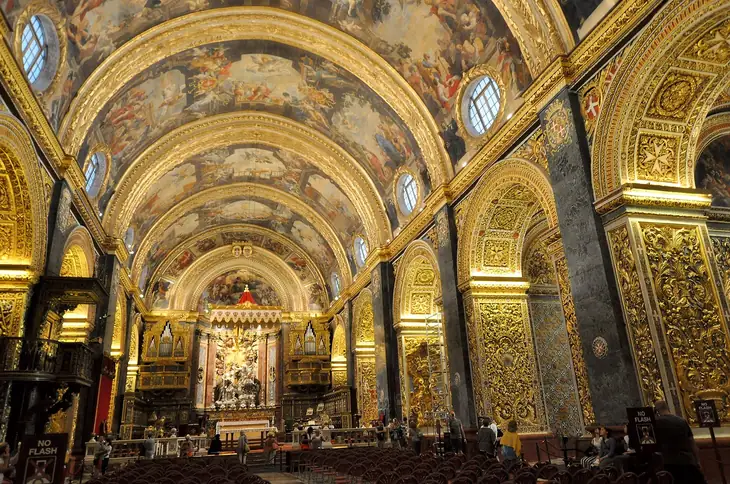
St. John's Co-Cathedral | Image by Herbert Frank on Flickr
St. John’s Co-Cathedral might have a sombre and rather dull exterior, but its interior is quite remarkable and a must-see for any visitor to the islands. The church was built between 1573 and 1578 as the conventual church of the Knights of St. John, and each of the eight langues, or nationalities, of the Order had its own chapel.
The church is a masterpiece of baroque art and architecture, with a rich and lavish interior covered with paintings, sculptures, and gold. The church also houses the Caravaggio masterpiece “The Beheading of St. John the Baptist,” which is the only painting that the artist signed and one of the largest and most dramatic paintings in the world.
Grand Master’s Palace

The Grandmaster's Palace | Image by M W from Pixabay
The Grand Master’s Palace is the largest and most prominent building in Valletta and a symbol of the power and prestige of the Knights of St. John. The palace was built between 1571 and 1574 as the residence of the Grand Master of the Order and the administrative and judicial centre of the island.
The palace has several rooms and halls, each with its own history and decoration, such as the throne room, the state rooms, the armoury, and the tapestry chamber. The palace also has a beautiful courtyard with a fountain and statues.
The palace used to house the Maltese Parliament, but since this was moved to the building you can see to the right as you walk through the city’s main gate, the palace has undergone significant renovation and was re-opened to the public in early 2024.
Fort St. Elmo and the National War Museum
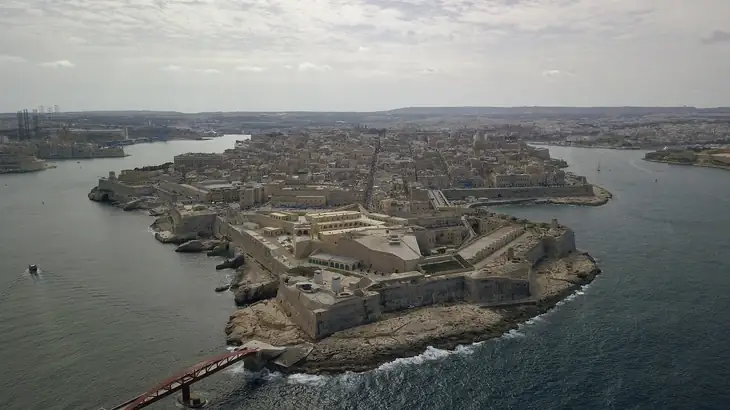
Valletta By Night | Image by Dion Hinchcliffe on Wikimedia Commons
Fort St. Elmo is a star-shaped fort that stands at the tip of the Valletta peninsula, guarding the entrance to the two harbours that surround Valletta. The fort was built in 1552 and was the first line of defence against the Ottoman invasion in 1565.
The fort was the scene of a heroic and bloody resistance by the Knights and the Maltese, who held out for a month against overwhelming odds until the fort was captured and almost completely destroyed. The fort was later rebuilt and strengthened, and it served as a military base until the 20th century.
Within the fort, one can find the National War Museum, which displays artefacts from Malta’s military history, from the Great Siege to World War II. The museum also exhibits the George Cross, the highest civilian award for bravery, which was awarded to Malta by King George VI in 1942 for its courage and resilience during the war.
The National Museum of Archaeology

Sleeping Lady at the National Museum of Archaeology | Image by Jean-Pierre Dalbéra on Flickr
Walking down Republic Street (the city’s main street), in between the many shops, one can visit the National Museum of Archaeology. The museum is located in the Auberge de Provence, a building that dates back to the foundation of the city and was the home of the knights who came from Provence, hence the name.
The museum is home to a collection of Neolithic relics, which includes pottery, jewellery, and stone tools. Along with a collection of mediaeval items, it also includes a collection of Roman artefacts, including mosaics and coins. It also has displays about the prehistoric period in Malta’s history, the Roman era, and the Middle Ages.
The history of the Knights during their stay in Malta is also well covered in the exhibitions, making this museum a must for anyone interested in the history of the islands.
Mdina: The Silent City
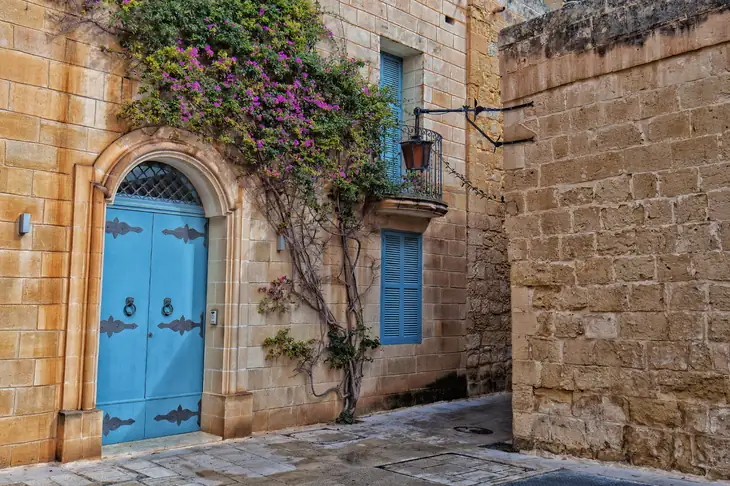
Mdina Blue Door | Image by Arne Dahl on Flickr
Mdina is the former capital of Malta and a mediaeval walled city, located on a hill in the centre of the island. Mdina was founded by the Phoenicians in the 8th century BC and was later occupied by the Romans, the Arabs, the Normans, and the Knights of St. John. Mdina is known as the “Silent City” because of its tranquil and serene atmosphere and its narrow and winding streets, which are mostly closed to traffic.
Mdina is a living museum with many historic buildings and monuments that reflect its rich and diverse history.
Here are some of the attractions in Mdina:
Mdina Dungeons
The Mdina Dungeons are a network of underground chambers that were used as a prison and a torture chamber during the rule of the Knights of St. John between 1530 and 1798. The dungeons are located under the Magisterial Palace and are accessed through a secret passage. The dungeons display scenes of the gruesome and cruel methods of torture and execution that were inflicted on the prisoners, such as the rack, the iron maiden, the wheel, and the guillotine.
The dungeons also tell the stories of some of the famous and infamous inmates, such as the rebel leader Dun Mikiel Xerri, the French spy Chevalier de Rohan, and the Turkish admiral Dragut. The dungeons are not for the faint-hearted, but they offer a fascinating and chilling insight into the dark side of Malta’s history.
St. Paul’s Cathedral

Mdina Cathedral | Image by Frank Vincentz on Wikimedia Commons
St. Paul’s Cathedral is the main church of Mdina and a masterpiece of baroque architecture. The cathedral was built between 1697 and 1702 on the site where St. Paul is believed to have converted the Maltese to Christianity after he was shipwrecked on the island in 60 AD. The cathedral has a magnificent facade, with two bell towers and a dome, and a splendid interior, with marble columns, paintings, and sculptures.
The cathedral also has a museum that displays a collection of silverware, vestments, and relics, including a piece of the column on which St. Paul was beheaded in Rome.
Palazzo Falson
Palazzo Falson is a 13th-century palace and the oldest building in Mdina that was originally the residence of a noble family. The palace was later acquired by Captain Olof Frederick Gollcher, a Maltese philanthropist and art collector, who restored it and filled it with his eclectic collection of paintings, furniture, books, jewellery, and antiques.
The palace is now a museum that showcases the life and interests of Gollcher and offers a glimpse into the history and culture of Mdina.
Rabat
Rabat is a town that is adjacent to Mdina and shares its ancient origins and history. Rabat was the suburb of Mdina, where most of the population lived outside the walls of the city. Rabat has several historic sites and attractions that are worth visiting, especially for those who are interested in the early Christian history of Malta.
Here are some of the places to see in Rabat:
St. Paul’s Catacombs

St. Paul's Catacombs | Image by flowcomm on Flickr
St. Paul’s Catacombs are a complex of underground burial chambers that date back to the Roman and Byzantine periods, between the 3rd and 8th centuries AD. The catacombs are the largest and most important evidence of the early Christian community in Malta and are named after St. Paul, who is said to have stayed in Rabat after his shipwreck. The catacombs consist of more than 30 hypogea, or underground chambers, that are connected by passageways and stairs.
The catacombs have several features, such as frescoes, inscriptions, symbols, and niches, that reveal the beliefs and customs of the people who were buried there. The catacombs also have a variety of tombs, such as sarcophagi, arcosolia, and baldacchini, that reflect the social status and preferences of the deceased.
Complementing the St. Paul’s Catacombs, one can also visit the St. Agatha’s complex, which is nearby.
Wignacourt Museum
The Wignacourt Museum is a 17th-century baroque palace that was built by Grand Master Alof de Wignacourt as a residence for the chaplains of the Order of St. John. The palace is a fine example of baroque architecture, with a grand staircase, a courtyard, and a loggia.
The palace houses a collection of religious art and artefacts, such as paintings, sculptures, tapestries, and silverware, that span from the 15th to the 20th centuries.
The site also has a chapel dedicated to St. Paul, which is built over the grotto where the saint is believed to have lived and prayed during his stay in Malta. The chapel has a statue of St. Paul and a painting of his shipwreck by the Maltese artist Mattia Preti.
Domus Romana

Domus Romana
The Domus Romana is a Roman townhouse that was discovered in 1881 and is located near the entrance to the catacombs. The townhouse was built in the 1st century AD and was occupied by a wealthy Roman family who enjoyed a comfortable and luxurious lifestyle.
The townhouse has well-preserved mosaic floors that depict geometric and floral patterns and scenes from Greek mythology. The townhouse also has a small museum that displays a collection of Roman artefacts, such as pottery, coins, lamps, and jewellery.
The Three Cities
The Three Cities are the collective name for the cities of Vittoriosa, Senglea, and Cospicua, also known by their Maltese names of Birgu, L-Isla, and Bormla, respectively. These cities are located across the Grand Harbour from Valletta and form the oldest part of Malta.
The Three Cities have a long and illustrious history, dating back to Phoenician and Roman times and reaching their peak during the rule of the Knights of St. John, who made Birgu their first headquarters in Malta. The Three Cities are rich in maritime history and fortifications and offer a glimpse into the authentic and traditional life of Malta.
Here are some of the sights to see in the Three Cities:
Fort St. Angelo
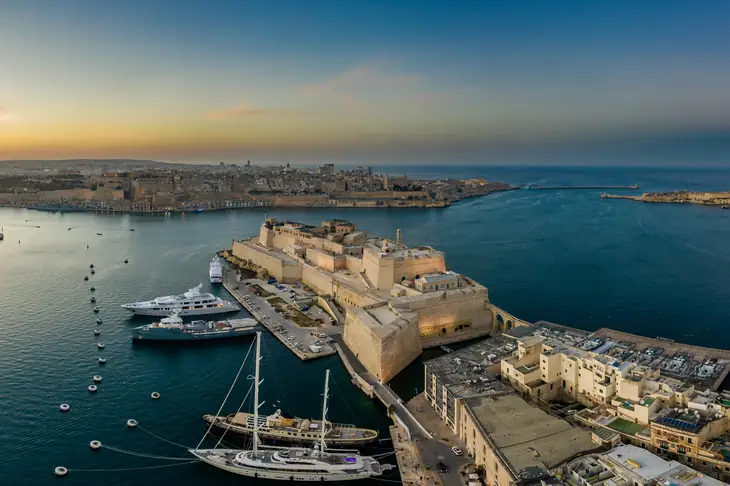
Fort St. Angelo | Image by FritzPhotography on Wikimedia Commons
Fort St. Angelo is a mediaeval castle that stands on a promontory at the tip of Birgu and dominates the Grand Harbour. The fort was originally a Roman fortification and was later expanded and strengthened by the Arabs, the Normans, and the Knights of St. John. The fort served as the headquarters of the Knights of St. John and was the scene of a heroic defence during the Great Siege of 1565, when a small garrison of knights and soldiers resisted the Ottoman attack for four months.
The fort was later used as a British naval base and played a vital role in World War II, when it was bombed and damaged by the Axis forces. The fort is now a museum that displays the history and legacy of the fort and offers stunning views of the harbour and the city.
The Inquisitor’s Palace
The Inquisitor’s Palace is a 16th-century palace that was built by the Knights of St. John as a law court and a prison. The palace was later converted into the seat of the Inquisition in Malta in 1574 and remained so until 1798, when the French abolished the Inquisition. The palace was the residence of the Inquisitor, who was the supreme authority on matters of faith and morality and who had the power to interrogate, torture, and punish anyone who was suspected of heresy or witchcraft.
The palace is now a museum that displays the history and effects of the Inquisition and the life and work of the Inquisitor. The museum also preserves some of the original rooms and features of the palace, such as the tribunal, the prison cells, the torture chamber, and the chapel.
Maritime Museum

Il-Karrakka at the Malta Maritime Museum | Image byContinentaleurope on Wikimedia Commons
The Maritime Museum is a museum that showcases Malta’s naval and maritime history, from the Phoenicians to the present day. The museum is located in a former naval bakery that was built by the British in the 19th century and is one of the largest industrial buildings in Malta. The museum displays a collection of artefacts, models, paintings, and documents that illustrate the various aspects and phases of Malta’s maritime history, such as trade, exploration, warfare, shipbuilding, and navigation.
The museum also exhibits some of the most important and unique items of Malta’s maritime heritage, such as the largest known Roman anchor in the world, the figurehead of the HMS Hibernia, and the ceremonial barge of Grand Master Manuel Pinto da Fonseca.
The museum will re-open to the public on February 9, 2024.
Gozo
While the majority of Malta’s residents live on the island of Malta, around five to 10 percent of the island’s inhabitants call the nearby island of Gozo home. The island can be reached after a short 20-minute trip by boat from the port of Cirkewwa in the north of Malta.
While we have already listed one of Gozo main attractions (the Ġgantija Temples), Għawdex, as it is known in Maltese, has a lot more historical sites to offer. Here are some highlights:
The Citadel

Citadel | Image by FritzPhotography on Wikimedia Commons
The main town of Gozo is Victoria and at its heart lies the Citadel, a castle that served as a refuge for the population of Gozo during the Middle Ages. The area which is also known as Rabat to the locals, has been inhabited all the way since the Bronze Age and it is thought that the acropolis of the Punic-Roman city of Gaulos once stood here.
Today, the main attraction at the Citadel is the Cathedral of the Assumption which is famous for its painting on the ceiling of a dome that stands in for the physical dome that was never built. Apart from the cathedral, one can find various other sites with the Citadel walls. Most notably, one can visit the Old Prison, the Gozo Nature Museum, the Gozo Museum of Archaeology and the Gran Castello Historic House.
While it is free to get into the Citadel you must purchase a ticket to access these sites. Nevertheless, the views of the entire island you get from the Citadel make it well worth the trip.
Ta’ Kola Windmill

Ta' Kola Windmill | Image by DianeBorg1 on Wikimedia Commons
The Ta’ Kola Windmill was initially constructed in 1725, during the rule of Grand Master Manoel de Vilhena and is located not far from the Ġgantija Temples. The knights used to finance the building of these kind of windmills, which then used to be leased out to private individuals. The windmill takes its name from Nikola (or Kola in short) Grech, who ran the windmill till the beginning of the 20th century.
After Kola’s death, the windmill passed to his son Ġuzeppi, who lived there and kept it running until his death in 1987. The building was later converted into a museum and the ground floor of the windmill now houses a sizable collection of Ġuzeppi’s tools.
Ta’ Pinu Basilica

Ta' Pinu Basilica | Image by Mojca-Peter from Pixabay
Malta is said to have a church for every day of the year, but one of the most beloved by both Maltese and Gozitans is the Ta’ Pinu Basilica. The origins of the shrine are not well known and the oldest record we have of it is when it got mentioned in the Curia’s archives in Gozo when Bishop Domenico Cubelles visited the chapel. The archives state that the chapel had recently been rebuilt and belonged to “The Gentile’s” noble family.
Opposite the church, one can find a path that leads to the top of a hill. Along the path, one can admire statues representing the 13 stations of the cross.
Other Sites
While the above section clustered the sites based on their location or group, there are definitely some other sites spread throughout the islands that are well worth the visit. Here are some you should definitely to consider:
The Hypogeum Temple of Hal Saflieni
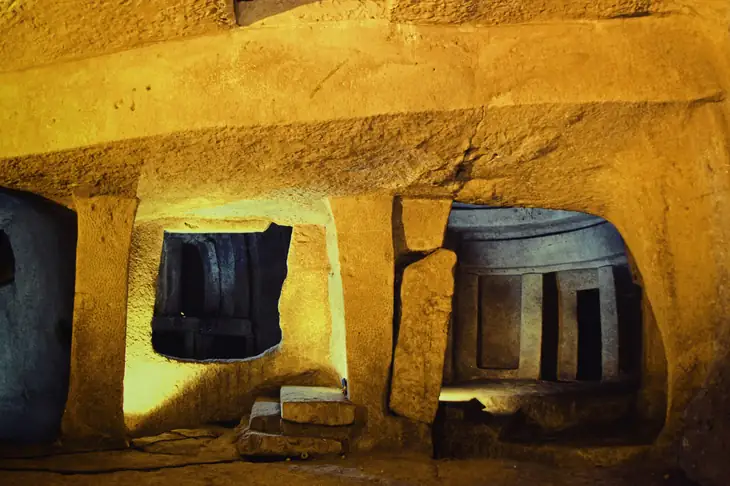
Hypogeum
The Hypogeum Temple of Hal Saflieni is an underground complex of chambers, halls, and passages that dates back to the Neolithic period, between 4000 and 2500 BC. It is the only known prehistoric underground temple in the world, and it was used as a sanctuary and a necropolis by the ancient Maltese people.
The Hypogeum Temple of Hal Saflieni is located in the town of Paola, not far from the Tarxien Temples. It was accidentally discovered in 1902 by a stone mason who was digging a cistern for a new housing development. Since then, it has been excavated and preserved by archaeologists, who have found many artefacts, human bones, and sculptures inside.
The hypogeum is divided into three levels, each with its own characteristics and functions. The upper level is the oldest and simplest, consisting of a large hollow with burial chambers on each side. The middle level is more elaborate and resembles the above-ground megalithic temples of Malta, with carved niches, altars, and trilithons. The lower level is the deepest and most mysterious, with a circular chamber that has four side niches and a remarkable acoustic effect.
The Hypogeum Temple is another entry that the Maltese islands have on the UNESCO World Heritage Site List and a testimony to a vanished civilization. It is open to the public, but only a limited number of visitors are allowed per day to protect the delicate environment and preserve the ancient atmosphere, so make sure you book your tickets well in advance.
The Red Tower

The Red Tower | Image by Tony Hisgett on Flickr
The Red Tower (also known as Saint Agatha’s Tower) is a 17th-century fortification located on the north coast of Malta. This tower was built by the Knights of St. John and was used as a defence against invading forces. Today, after a significant restoration, the Red Tower is open as a museum.
Apart from exploring the interior of the tower, one can get to the roof of the tower, which offers panoramic views of the northern coast and Mellieħa Bay.
Għar Dalam

Għar Dalam
Għar Dalam, which translates to “Cave of Dalam,” is a 144-metre-long cave outside of Birżebbuġa, the southernmost town in Malta. At the end of the last ice age, various species of animals got stranded in Malta as the sea level rose and disconnected Malta from Sicily and North Africa. These animals have since become extinct, and bone remains were found inside the cave. The cave also has evidence that it was used by the first settlers of Malta.
Apart from visiting the cave, the site has an exhibition of the remains of dwarf elephants, hippopotamuses, giant swans, deer, and bears, all of whose bones were found in the cave.
Conclusion
Malta and Gozo might be small islands, but they are rich with a history that spans thousands of years. From the Megalithic Temples to the fortifications built by the Knights of St. John, these islands are home to a number of fascinating historical sites that are sure to captivate visitors of all interests.
So, whether you’re an archaeology enthusiast or just looking for a unique vacation destination, the Maltese Islands are sure to impress.
Frequently Asked Questions
What are the top historical sites in Malta?
Malta has a number of locations listed on the UNESCO World Heritage Site list. These include Valletta, Malta's fortified capital; the Hal Saflieni Hypogeum, an underground temple dating back to 4000 BC; and seven megalithic temples, which include Ħaġar Qim, Tarxien Temples, Mnajdra Temples and Ġgantija Temples on the island of Gozo.
What are the best museums in Malta?
The National Museum of Archaeology in Valletta displays a large collection of artefacts spanning the entire 7,000-year history of the islands. Apart from the National Museum of Archaeology, there are various other museums dedicated to specific areas, like the National War Museum, the Mdina Cathedral Museum, the Malta Maritime Museum, the Gozo Nature Museum and the Gozo Museum of Archaeology.
Is Malta an independent country?
Malta obtained its independence from the British in 1964 and has been a member of the European Union since 2004.
What are the Megalithic Temples of Malta?
The Megalithic Temples of Malta are a series of prehistoric temples built during the Neolithic period, around 2500–2300 BC. They are considered to be some of the oldest free-standing structures in the world.
When is the best time to visit the historical sites of Malta and Gozo?
The best time to visit the historical sites in Malta and Gozo is between April and June, when the weather will not be very hot and peak tourist season will not have kicked off, so you can avoid the crowds.







